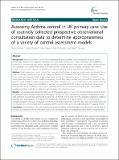Files in this item
Assessing asthma control in UK primary care : Use of routinely collected prospective observational consultation data to determine appropriateness of a variety of control assessment models
Item metadata
| dc.contributor.author | Hoskins, Gaylor | |
| dc.contributor.author | Williams, Brian | |
| dc.contributor.author | Jackson, Catherine Miriam | |
| dc.contributor.author | Norman, Paul D. | |
| dc.contributor.author | Donnan, Peter T. | |
| dc.date.accessioned | 2012-07-25T13:31:01Z | |
| dc.date.available | 2012-07-25T13:31:01Z | |
| dc.date.issued | 2011-09-29 | |
| dc.identifier | 22612516 | |
| dc.identifier | 9baf109d-4f05-4a2e-bac4-f5051f48b5ff | |
| dc.identifier | 000295983300001 | |
| dc.identifier | 80053173765 | |
| dc.identifier.citation | Hoskins , G , Williams , B , Jackson , C M , Norman , P D & Donnan , P T 2011 , ' Assessing asthma control in UK primary care : Use of routinely collected prospective observational consultation data to determine appropriateness of a variety of control assessment models ' , BMC Family Practice , vol. 12 , 105 , pp. - . https://doi.org/10.1186/1471-2296-12-105 | en |
| dc.identifier.issn | 1471-2296 | |
| dc.identifier.uri | https://hdl.handle.net/10023/3014 | |
| dc.description.abstract | Background: Assessing asthma control using standardised questionnaires is recommended as good clinical practice but there is little evidence validating their use within primary care. There is however, strong empirical evidence to indicate that age, weight, gender, smoking, symptom pattern, medication use, health service resource use, geographical location, deprivation, and organisational issues, are factors strongly associated with asthma control. A good control measure is therefore one whose variation is most explained by these factors. Method: Eight binary (Yes = poor control, No = good control) models of asthma control were constructed from a large UK primary care dataset: the Royal College of Physicians 3-Questions (RCP-3Qs); the Jones Morbidity Index; three composite measures; three single component models. Accounting for practice clustering of patients, we investigated the effects of each model for assessing control. The binary models were assessed for goodness-of-fit statistics using Pseudo R-squared and Akaikes Information Criteria (AIC), and for performance using Area Under the Receiver Operator Characteristic (AUROC). In addition, an expanded RCP-3Q control scale (0-9) was derived and assessed with linear modelling. The analysis identified which model was best explained by the independent variables and thus could be considered a good model of control assessment. Results: 1,205 practices provided information on 64,929 patients aged 13+ years. The RCP-3Q model provided the best fit statistically, with a Pseudo R-squared of 18%, and an AUROC of 0.79. By contrast, the composite model based on the GINA definition of controlled asthma had a higher AIC, an AUROC of 0.72, and only 10% variability explained. In addition, although the Peak Expiratory Flow Rate (PEFR) model had the lowest AIC, it had an AUROC of 71% and only 6% of variability explained. However, compared with the RCP-3Qs binary model, the linear RCP-3Q Total Score Model (Scale 0-9), was found to be a more robust 'tool' for assessing asthma control with a lower AIC (28,6163) and an R-squared of 33%. Conclusion: In the absence of a gold standard for assessing asthma control in primary care, the results indicate that the RCP-3Qs is an effective control assessment tool but, for maximum effect, the expanded scoring model should be used. | |
| dc.format.extent | 12 | |
| dc.format.extent | 1023250 | |
| dc.language.iso | eng | |
| dc.relation.ispartof | BMC Family Practice | en |
| dc.subject | RA0421 Public health. Hygiene. Preventive Medicine | en |
| dc.subject | SDG 3 - Good Health and Well-being | en |
| dc.subject.lcc | RA0421 | en |
| dc.title | Assessing asthma control in UK primary care : Use of routinely collected prospective observational consultation data to determine appropriateness of a variety of control assessment models | en |
| dc.type | Journal article | en |
| dc.contributor.institution | University of St Andrews. School of Medicine | en |
| dc.identifier.doi | https://doi.org/10.1186/1471-2296-12-105 | |
| dc.description.status | Peer reviewed | en |
This item appears in the following Collection(s)
Items in the St Andrews Research Repository are protected by copyright, with all rights reserved, unless otherwise indicated.

